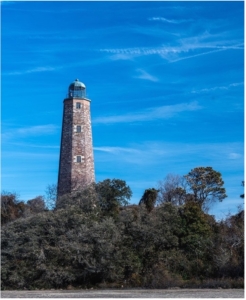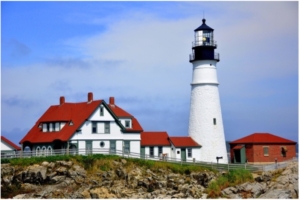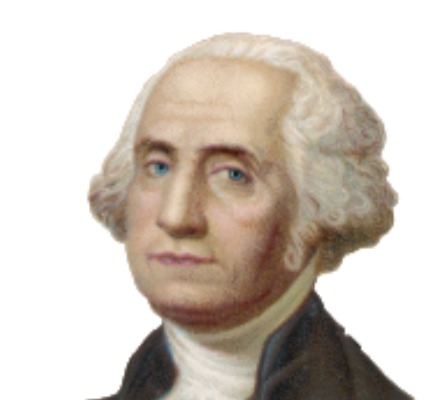To commemorate President’s Day in the backdrop of a presidential election year, Eno is kicking off a series of articles about transportation relating to U.S. presidents. Not only are these stories fascinating, but they also reveal how previous generations navigated dramatic transportation changes.
Embarking with this “inaugural” edition, you will learn how changing transportation policies and technologies, from lighthouses to electric vehicles, have had a profound effect on our lives. In the 18th century, the American economy thrived because of our Atlantic seaports. In the 19th century, canals, steam-powered boats, and railroads helped create mighty cities along the Mississippi River and the Great Lakes. In the 20th century, streetcars and subways brought people to downtowns and then highways spread out our homes, factories, offices, and stores.
New transportation projects and technologies shape how and where we live, and they are also important symbols of an interconnected, sprawling country. The transcontinental railroad, interstate highways, and the first trip to the moon were all great sources of national pride.
After reading about our presidents, you will be surprised, better informed, and have a different perspective about our country. We promise.
George Washington, the First President
The Eno Center was founded in 1921 by William Phelps Eno, who had a passion for improving traffic safety. So too did the “father of our country.”
After his inauguration in 1789, one of George Washington’s first priorities was improving navigation for mariners. His recommendations led to the ninth law passed by the newly established Congress: “An Act for the Establishment and Support of Lighthouse, Beacons, Buoys, and Public Piers,” and America’s first public works program.
The legislation reflected the influence of the northern states (whose ports had rocky and treacherous coastlines) and Philadelphia merchants (who wanted public piers). The issue was such a high priority that Congress passed it before it had even created the post office, established the federal courts, or set the president’s salary.
The federal government subsequently assumed ownership and responsibility for the 12 original colonial lighthouses and authorized funding for new construction. Not only did the new American lighthouses become important navigational markers – warning mariners of dangerous rocks, reefs and currents — they also held significance as important symbols of the new nation.
Alexander Hamilton, the Secretary of Treasury, oversaw the lighthouse construction. He and the president were personally involved in many of the construction details. Today, you can visit lighthouses completed during the Washington administration in Virginia, New York, and Maine.
 The Cape Henry Lighthouse in Virginia Beach was the first construction project authorized by the U.S. government. President Washington was the first commander-in-chief to get complaints about the federal government’s slow decision-making process and delayed payments. In a letter that you can read in the National Archives, he wrote:
The Cape Henry Lighthouse in Virginia Beach was the first construction project authorized by the U.S. government. President Washington was the first commander-in-chief to get complaints about the federal government’s slow decision-making process and delayed payments. In a letter that you can read in the National Archives, he wrote:
“I am sorry that you have not yet recd any of my outstanding debts, but am not without hope that you will be able to collect at least some part of them shortly. This case is hard, and I believe singular. I am, Sir, Your most Obedt Sert.”
– G. Washington

On the easternmost tip of Long Island, the Montauk Point Lighthouse helped guide sailors into New York’s harbor more than 100 miles to the west. The lightkeeper kept the lanterns lit, and lived in a small adjacent home with his family where they grew their own vegetables, raised livestock, and caught fish.
 The 72-foot high Portland Head Lighthouse in Maine was lit with 16 whale oil lamps. President Washington personally approved the appointment of the first light keeper, a Revolutionary War veteran.
The 72-foot high Portland Head Lighthouse in Maine was lit with 16 whale oil lamps. President Washington personally approved the appointment of the first light keeper, a Revolutionary War veteran.
In the next article, you can read about President John Adams, who was elected in 1796. As George Washington’s vice president, Adams complained to his wife Abigail, “My country has in its wisdom contrived for me the most insignificant office that ever the invention of man contrived or his imagination conceived.”
Source of Photos: Virginia (PumpkinSky), New York (Peter K Burian), Maine (Aniarku)
Check out all of the articles in our Presidential Series by visiting our archive!

 The Cape Henry Lighthouse in Virginia Beach was the first construction project authorized by the U.S. government. President Washington was the first commander-in-chief to get complaints about the federal government’s slow decision-making process and delayed payments. In a
The Cape Henry Lighthouse in Virginia Beach was the first construction project authorized by the U.S. government. President Washington was the first commander-in-chief to get complaints about the federal government’s slow decision-making process and delayed payments. In a 
 The 72-foot high Portland Head Lighthouse in Maine was lit with 16 whale oil lamps. President Washington personally approved the appointment of the first light keeper, a Revolutionary War veteran.
The 72-foot high Portland Head Lighthouse in Maine was lit with 16 whale oil lamps. President Washington personally approved the appointment of the first light keeper, a Revolutionary War veteran.


